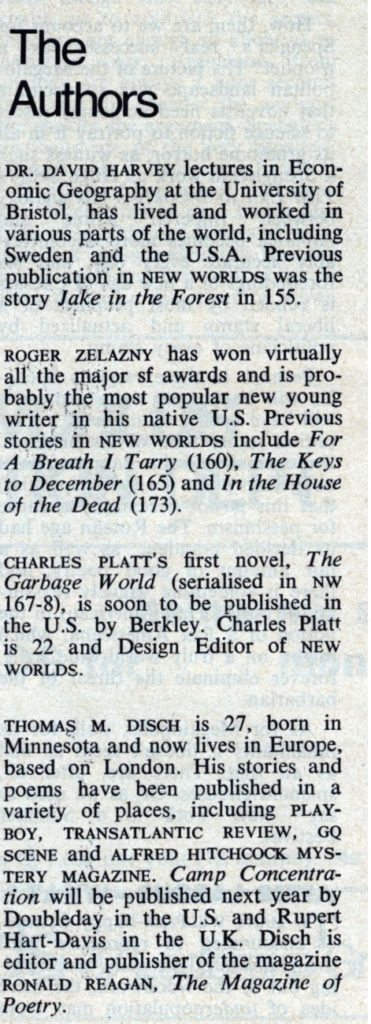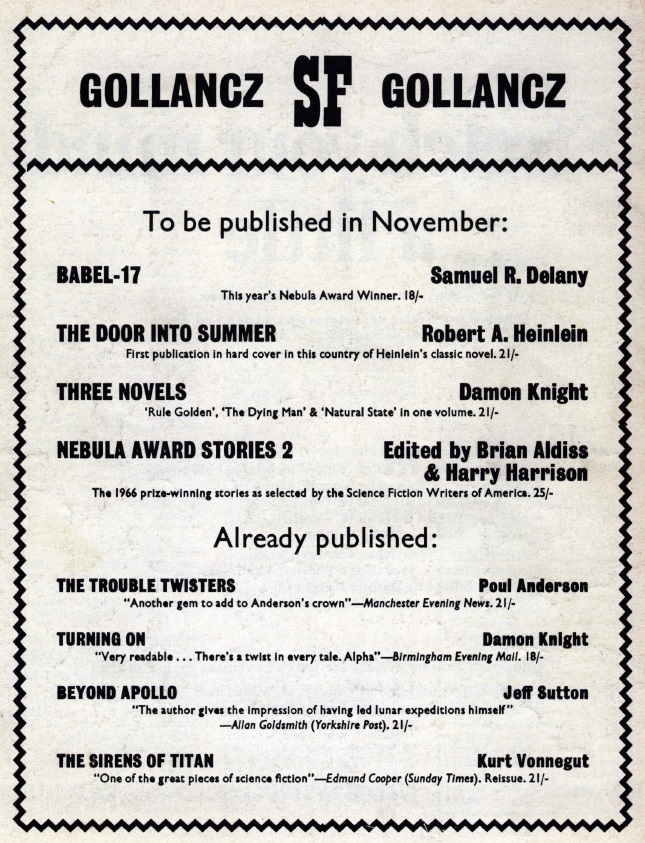
by Fiona Moore
Hello! I’m taking over the New Worlds reviews from Mark Yon, which is a little intimidating, but I hope I’ll be able to live up to his excellent legacy.
On the UK Star Trek broadcast front, I missed “Mudd’s Women” due to having to take a work trip to Glasgow, but “A Taste of Armageddon” was decent anti-war satire if a bit heavy-handed. Having seen a few episodes in colour on trips to North America, I have to say it works less well in black and white, but at least we do get the idea.
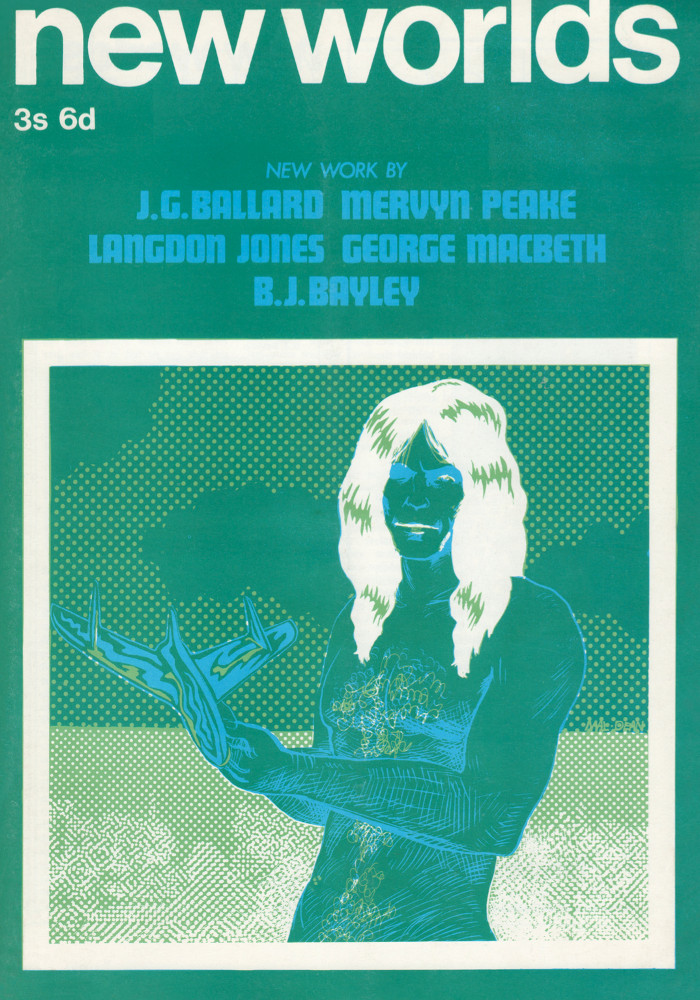 Cover for New Worlds, September 1969
Cover for New Worlds, September 1969
Lead-In (New Worlds 194) by The Publishers
This is brief, without the edge of hysteria from last month, which leads me to hope that they’ve got the financial issues under control. It’s also good to know that JG Ballard has a collection coming out, The Atrocity Exhibition. The lineup this month features regular contributors and well-known people on the New Wave scene, but perhaps it’s a little too conservative as a result. Three stars.
A Place and a Time to Die by JG Ballard
 Art by Mal dean
Art by Mal dean
This story is about an implied Chinese Communist takeover of an implied USA, though with a degree of vagueness as to time and place. It follows two men attempting to hold the line as the invaders, or maybe exponents of an internal coup, come into town. This is a bleak description of warfare; no one is heroic and everyone is ugly. It also highlights how ideological takeovers can be more powerful than armed ones. Four stars.
Pictures from an Exhibition 9 and 10 by Giles Gordon
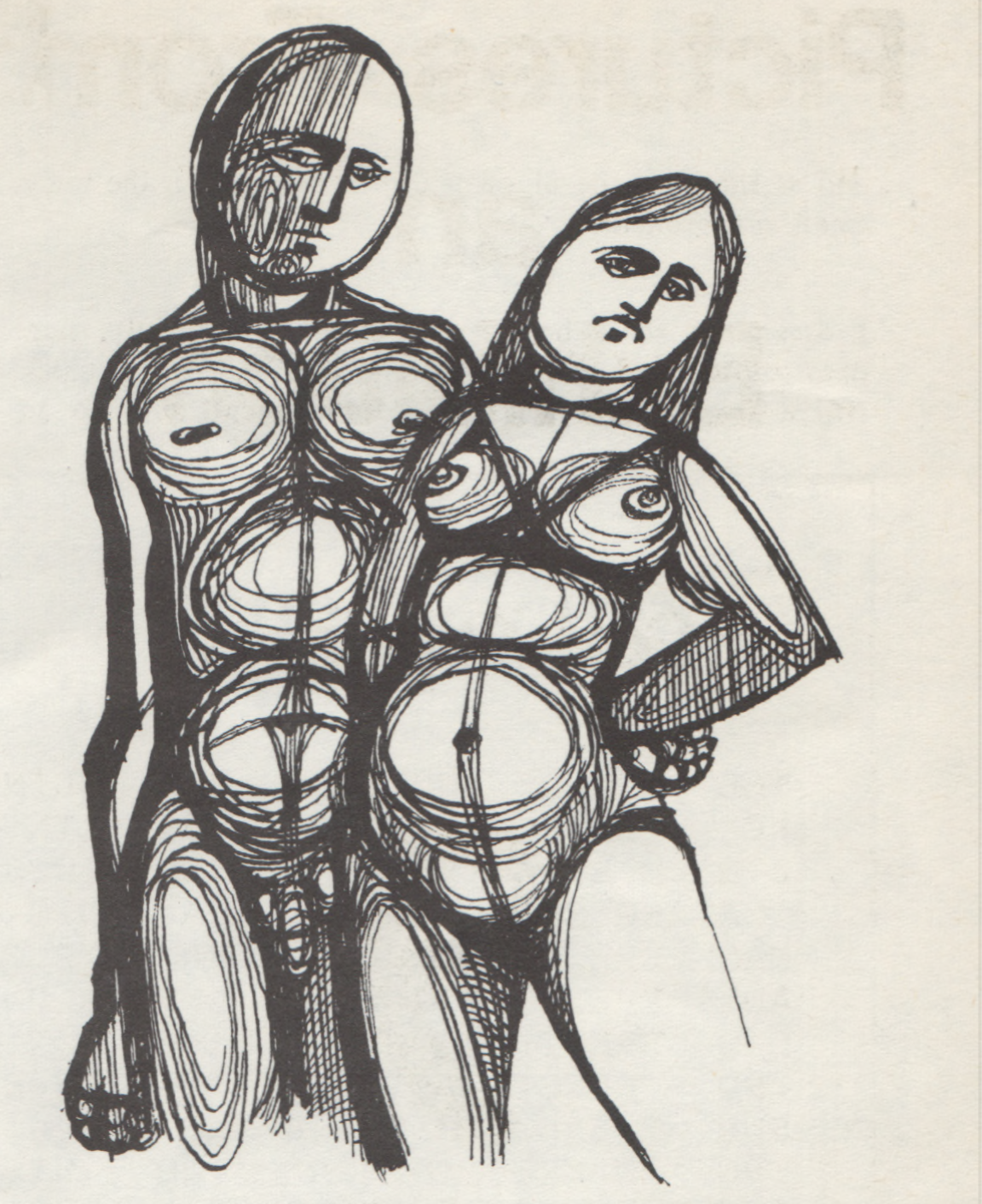 Artist unknown
Artist unknown
Two vignettes, inspired by pictures in a Sunday colour supplement, and part of a longer work. The two pictures have little in common apart from featuring in the same publication, and the point seems to be both to draw narratives out of the images and to highlight how newspapers juxtapose unrelated imagery, causing the reader to look for meaning. Three stars.
Transplant by Langdon Jones
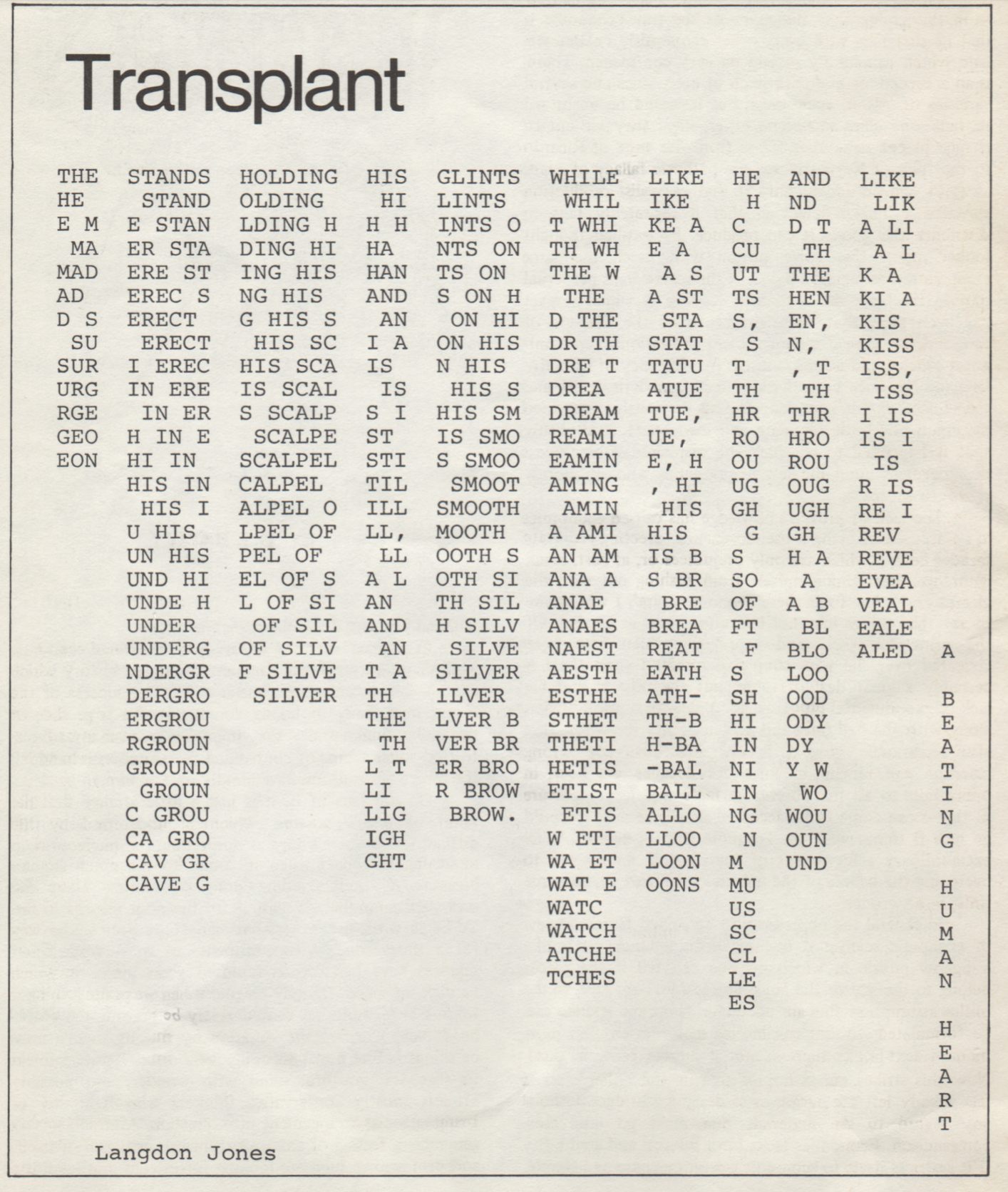 The text of Transplant, with concrete effects
The text of Transplant, with concrete effects
A concrete poem about a heart transplant. It’s dramatic and evocative, making one think about how horrific even a life-saving surgical procedure really is. Cutting open humans and sticking new hearts in them is a horrifiying idea, and yet lives are saved. Four stars.
The Incomplete Science by B.J. Bayley
This is a non-fiction piece on economics, a concept SFF writers ignore far too often. The author presents two sets of economic dynamics, one relating to production and the other to land values, and concludes without reconciling them. The subject is very interesting but unfortunately it’s also very dry. Two stars.
The Capitol by George MacBeth
This is a series of sonnets that appear to be found poetry, a set of lines from newspaper stories all thrown together out of context. Like “Pictures at an Exhibition”, the only real meaning I could discern was to point out the absurdity of capitalism and journalism. I’m afraid it left me cold. Two stars.
The Party at Lady Cusp-Canine’s by Mervyn Peake
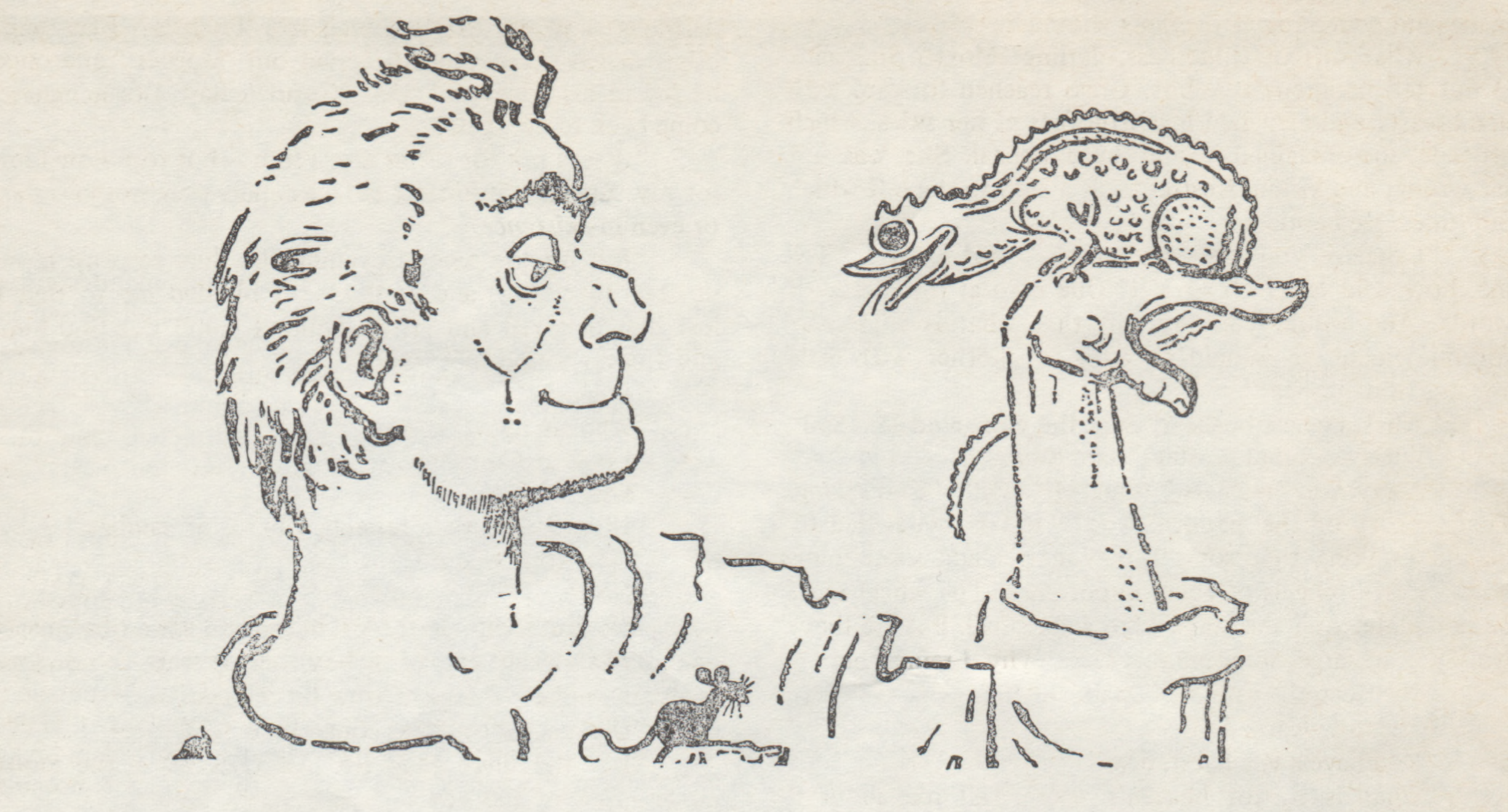 Art by, of course, Mervyn Peake
Art by, of course, Mervyn Peake
This is one of the issue’s highlights, including an essay by Langdon Jones. It seems that the original edition of Peake’s posthumous novel Titus Alone excluded a lot of good material and was poorly edited, and Jones has done a lot of work trying to develop a new edition which is closer to what Peake intended. As a Peake fan I’m thrilled by the news, and hoping that the revived Titus Alone will be something more in the style of the first two Gormenghast novels. The excerpt is certainly in line with Peake’s ascerbic wit, capturing the brittle nastiness of cocktail parties with a plethora of evocative animal names and similies. There is also brief news about another posthumous novel by Peake coming out, Mr Pye, which should be worth comparing to his earlier fiction. Five stars.
Lines of White on a Sullen Sea by Maxim Jakubowski
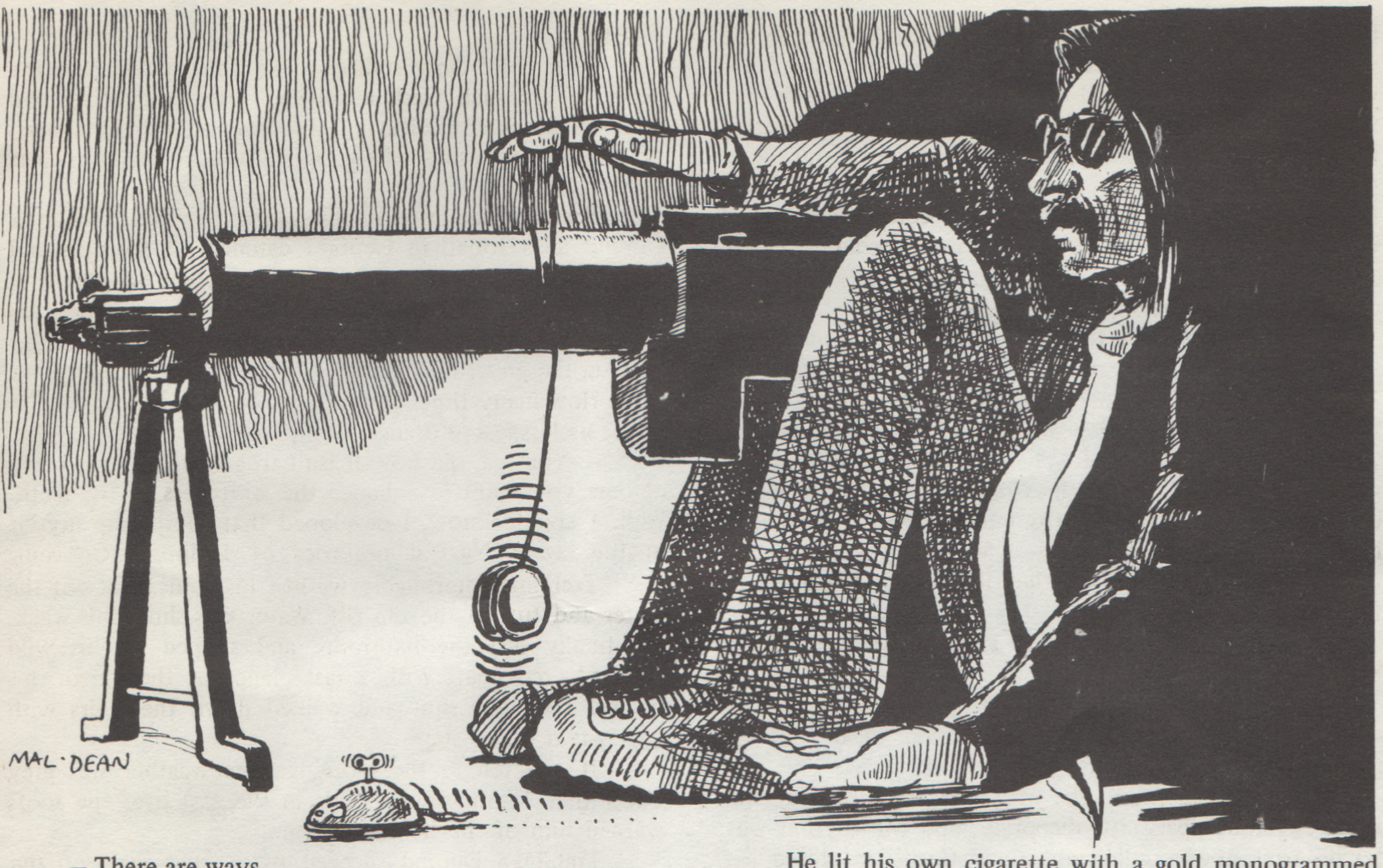 Art by Mal Dean
Art by Mal Dean
This is the latest in the ongoing shared-author story featuring Jerry Cornelius. It doesn’t make any more sense than the other ones, but making sense is less of a priority than evoking a mood. Jerry is preoccupied with a Chinese rival; a female Cornelius turns up; there are lovely descriptions of clothes, and characters with absurd names like Treblinka Durand. If you liked the previous entries you'll probably like this. Three stars.
Books (New Worlds 194)
This issue contains no less than five full pages of book reviews, making the reviews section longer than any of the stories. This is a bit much, particularly given the magazine’s current reduced page count.
Slum Clearance by John Clute
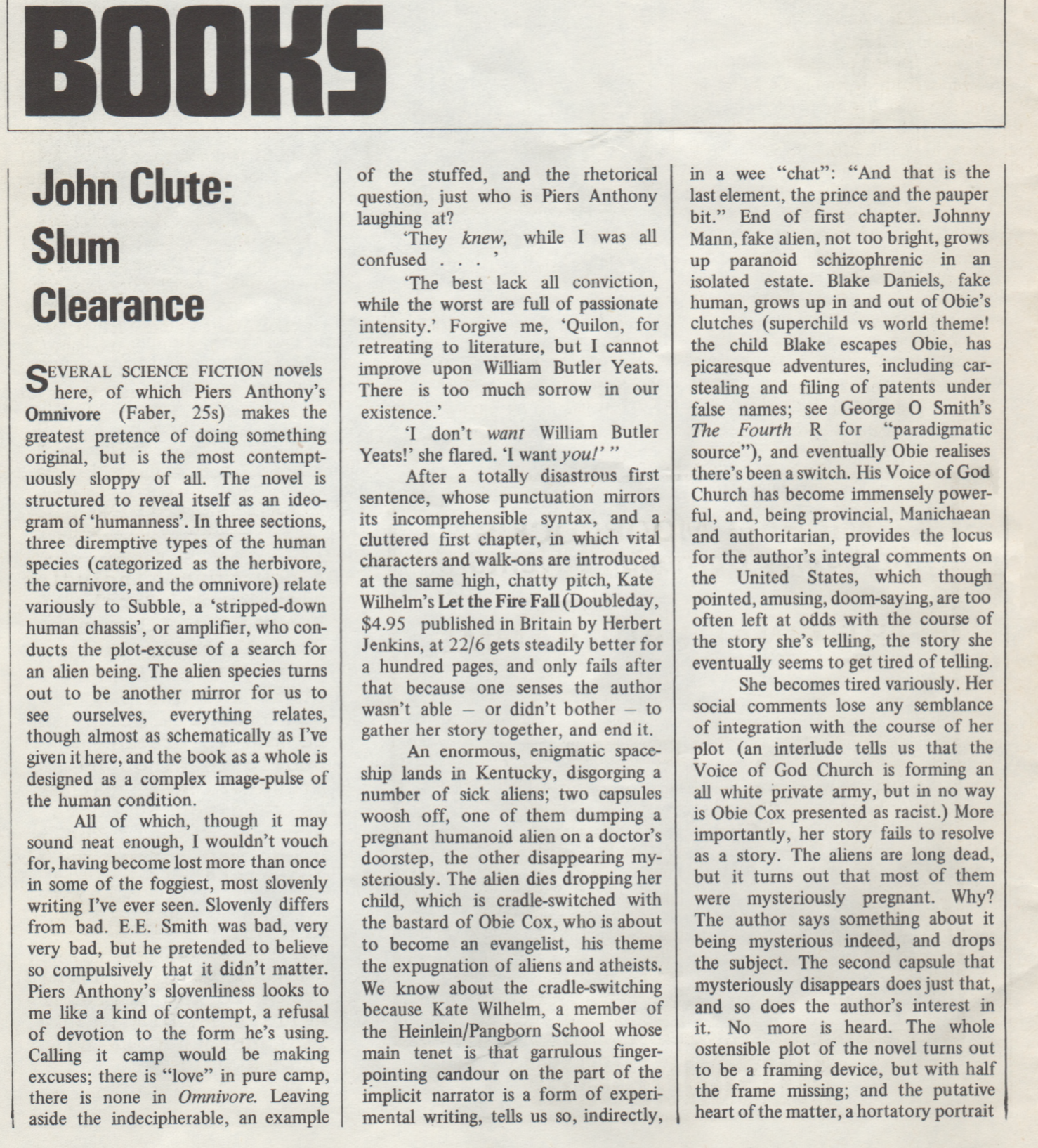 John Clute's book reviews
John Clute's book reviews
Clute reviews Omnivore by Piers Anthony, Let the Fire Fall by Kate Wilhelm, Retief: Ambassador to Space by Keith Laumer, Brother Assassin by Fred Saberhagen, The Mezentian Gate, an unfinished novel by by E.R. Eddison, and The Left Hand of Darkness by Ursula K. Le Guin. He quite likes the Le Guin, is scathing about the Anthony, Laumer and Saberhagen, and mixed on everything else. Three stars.
Come Alive—You’re in the William Sanson Generation by Joyce Churchill
Churchill reviews Death Goes Better with Coca Cola by Dave Godfrey, Cape Breton is the Thought Control Centre of Canada by Ray Smith, Galactic Pot-Healer by Philip K. Dick, The Island Under The Earth by Avram Davidson, and Penguin Modern Stories. She doesn’t seem too happy with any of them, and her comments didn’t leave me wanting to read any of them other than out of morbid curiosity. Two and a half stars.
Getting it Out by Norman Spinrad
Spinrad’s book review article, unlike the other two actually has a theme: he focuses on the output of Essex House, a paperback line whose agenda is to be for pornography what the New Wave has been to SF, leading to a subgenre of “speculative erotic fiction”. He reviews Season of the Witch by Hank Stine, Biker by Jane Gallion, the Agency trilogy by David Melzer, Evil Companions by Michael Perkins and A Feast Unknown by Philip Jose Farmer. Spinrad makes some of them, at least, sound intriguing. I’m going to keep an eye out for the Stine, a gender-bending body horror that sounds up my street. Four stars.
While at first glance it looks like the magazine is back on an even keel after last month’s financial woes, I’m still a bit worried. The writers are all White men with one exception (who I suspect is also White). Meanwhile, a recent trip to see Yoko Ono’s latest show has reminded me that London’s art and film and literature scene is simply exploding with talented people from all over the world. If NW wants to survive, simply writing about sex isn’t original enough any more; it needs to bring in some of the new voices on the scene.

![[August 22, 1969] Peake District: New Worlds September 1969](https://galacticjourney.org/wp-content/uploads/2024/08/Screen-Shot-2024-08-05-at-18.40.07-672x372.png)


![[March 24, 1969] Apocalypse Impending? <i>New Worlds</i>, April 1969](https://galacticjourney.org/wp-content/uploads/2024/03/New-Worlds-April-1969-672x372.jpg)

 The named list from last month.
The named list from last month. Cover by Mervyn Peake.
Cover by Mervyn Peake. In a post-apocalyptic US we are told of teenager Vic and his telepathic dog, Blood. Vic is a teenage boy who spends his time scavenging the world for basic needs—food, companionship, and sex—as well as generally avoiding other groups, known as roverpaks, doing the same thing. They meet Quilla June – unusual because most women live where it is safer, underground. Vic rapes Quilla June before they are attacked by another roverpak. Blood is hurt in the scuffle. Quilla June escapes and returns to her underground home of Topeka.
In a post-apocalyptic US we are told of teenager Vic and his telepathic dog, Blood. Vic is a teenage boy who spends his time scavenging the world for basic needs—food, companionship, and sex—as well as generally avoiding other groups, known as roverpaks, doing the same thing. They meet Quilla June – unusual because most women live where it is safer, underground. Vic rapes Quilla June before they are attacked by another roverpak. Blood is hurt in the scuffle. Quilla June escapes and returns to her underground home of Topeka.
 More poetry. Described as ‘a poem for light and movement’, Thomas manages to produce strange typewritten boxes that are at times undecipherable. A typical ‘form over content’ type piece. 2 out of 5.
More poetry. Described as ‘a poem for light and movement’, Thomas manages to produce strange typewritten boxes that are at times undecipherable. A typical ‘form over content’ type piece. 2 out of 5. The inevitable 'naked lady of the month' picture.
The inevitable 'naked lady of the month' picture.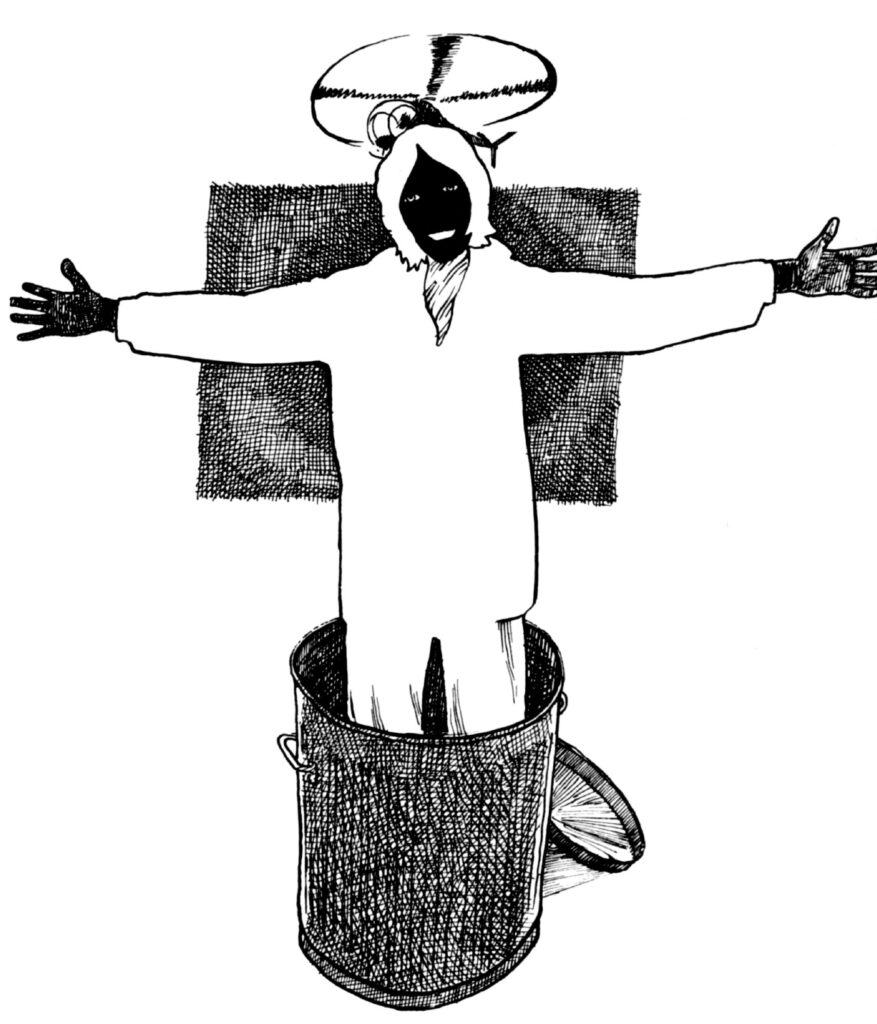 Artwork by Mal Dean.
Artwork by Mal Dean.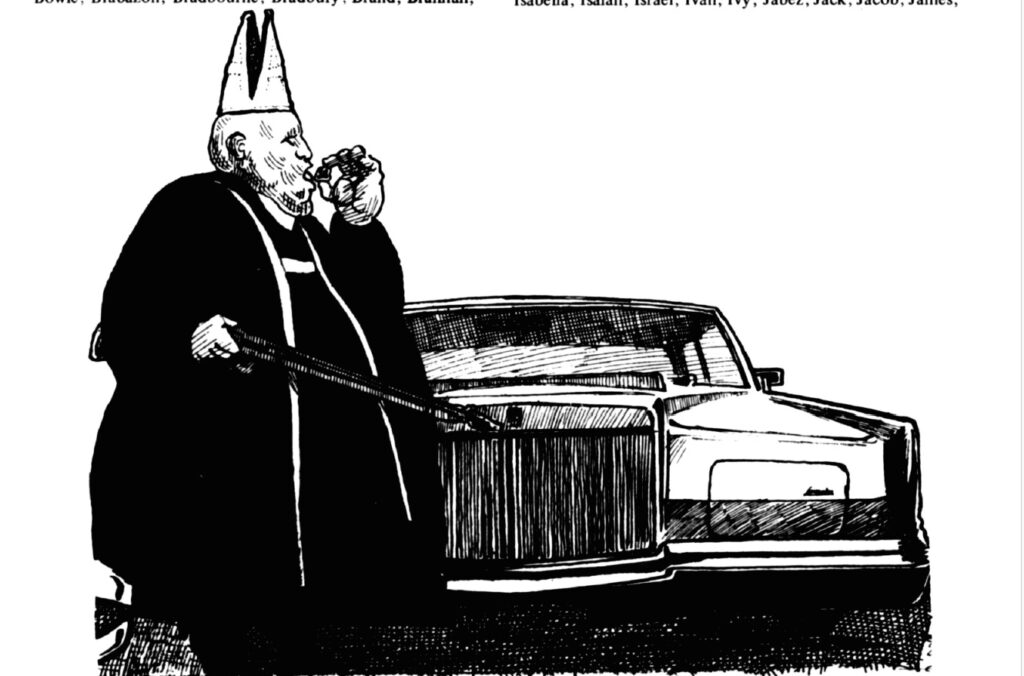 More artwork by Mal Dean.
More artwork by Mal Dean.
![February 26, 1969] Springtime for Moorcock? <i>New Worlds</i>, March 1969](https://galacticjourney.org/wp-content/uploads/2024/02/NW-March-1969-672x372.png)

 Cover by Gabi Nasemann. Is this Moorcock horrified by his announcement?
Cover by Gabi Nasemann. Is this Moorcock horrified by his announcement?  Artwork by Mal Dean.
Artwork by Mal Dean.
 The magazine’s obsession with D.M. Thomas continues, with something given under the premise that it is a transcript of speech from Mr. Black, a schizophrenic, as he is treated. As the story progresses, in
The magazine’s obsession with D.M. Thomas continues, with something given under the premise that it is a transcript of speech from Mr. Black, a schizophrenic, as he is treated. As the story progresses, in 
 Bizarre artwork by Mal Dean, seemingly stuck in at random in the middle of this story.
Bizarre artwork by Mal Dean, seemingly stuck in at random in the middle of this story. Artwork by Mal Dean.
Artwork by Mal Dean. Continuing the war theme, now with poetry, this time from writer and reviewer MacBeth. His last prose piece was in July 1967. The Hiroshima Dream touches on themes that seem very Ballardian, so it seems a logical piece to follow Ballard. Death, destruction, dystopia….fifty tankas* all based around apocalypse and the nuclear bomb dropping at Hiroshima. Although it is shockingly dark, I prefer MacBeth to D. M. Thomas. 4 out of 5.
Continuing the war theme, now with poetry, this time from writer and reviewer MacBeth. His last prose piece was in July 1967. The Hiroshima Dream touches on themes that seem very Ballardian, so it seems a logical piece to follow Ballard. Death, destruction, dystopia….fifty tankas* all based around apocalypse and the nuclear bomb dropping at Hiroshima. Although it is shockingly dark, I prefer MacBeth to D. M. Thomas. 4 out of 5.

![[January 26, 1969] A New World Order <i>New Worlds</i>, February 1969](https://galacticjourney.org/wp-content/uploads/2024/01/New-Worlds-Feb-1969-672x372.jpg)
 Impressively startling cover by Gabi Nasemann.
Impressively startling cover by Gabi Nasemann. As expected, the usual nudity, not entirely related to the prose. Artwork by Gabi Nasemann.
As expected, the usual nudity, not entirely related to the prose. Artwork by Gabi Nasemann.
 Artwork by Gabi Nasemann.
Artwork by Gabi Nasemann.
 Table made up by J. G. comparing different writers. Notice the positioning of Pohl and Asimov and that of Burroughs (presumably William S., not Edgar Rice!), a sign of where this magazine seems to be going.
Table made up by J. G. comparing different writers. Notice the positioning of Pohl and Asimov and that of Burroughs (presumably William S., not Edgar Rice!), a sign of where this magazine seems to be going. Artwork by Haberfield.
Artwork by Haberfield. Artwork by John T. Sladek.
Artwork by John T. Sladek.
 Work by Mervyn Peake.
Work by Mervyn Peake. Artwork by Prigann.
Artwork by Prigann. Artwork by Prigann.
Artwork by Prigann.
 Artwork by Gabi Nasemann and Charles Platt.
Artwork by Gabi Nasemann and Charles Platt.
 An advertisement from this issue of Peake's better-known work.
An advertisement from this issue of Peake's better-known work.

 Cover by Gabi Nasemann
Cover by Gabi Nasemann




 Just to be clear – New Worlds editors really like D. M. Thomas. As in, REALLY like. Declaring the poet to be “without question, one of England’s very best poets” in the Lead In, they like this particular poem so much it is available as a poster, courtesy of Charles Platt.
Just to be clear – New Worlds editors really like D. M. Thomas. As in, REALLY like. Declaring the poet to be “without question, one of England’s very best poets” in the Lead In, they like this particular poem so much it is available as a poster, courtesy of Charles Platt.
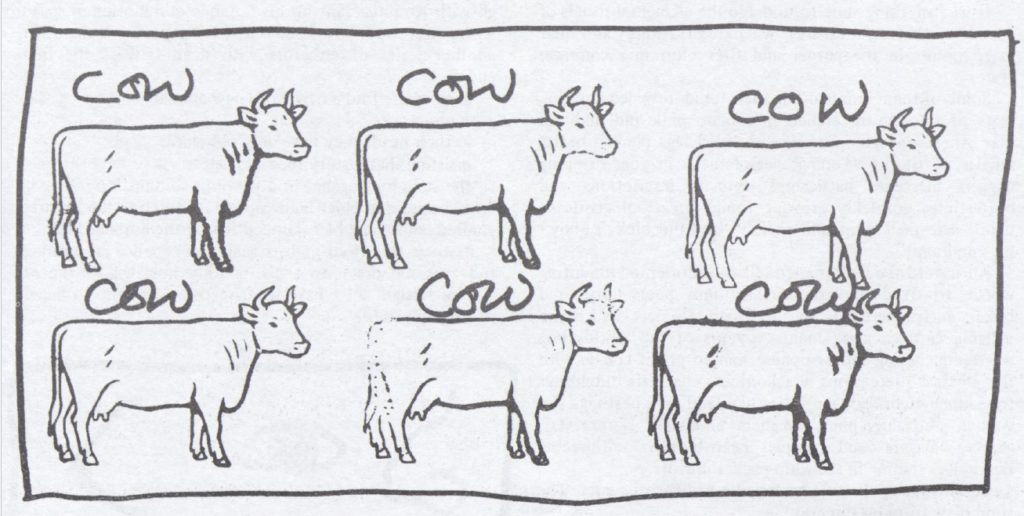
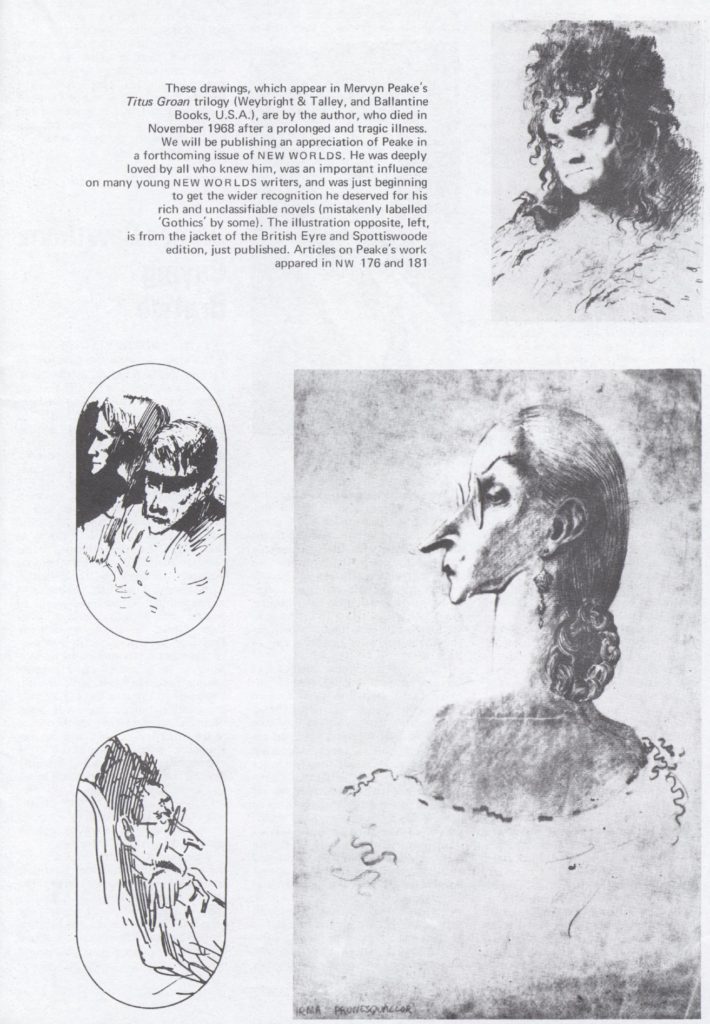
 On a more positive note, have a great Christmas, and I look forward to returning next year when (hopefully) I will be less grumpy. “Bah, Humbug!” and so forth.
On a more positive note, have a great Christmas, and I look forward to returning next year when (hopefully) I will be less grumpy. “Bah, Humbug!” and so forth.
![[March 26, 1968] Scandal! <i>New Worlds</i>, April 1968](https://galacticjourney.org/wp-content/uploads/2023/03/New-Worlds-April-1968-672x372.jpg)
 Cover by Stephen Dwoskin
Cover by Stephen Dwoskin 








![[September 26, 1967] Anniversary? Really? <i>New Worlds</i>, October 1967](https://galacticjourney.org/wp-content/uploads/2022/09/NW-October-1967-672x372.jpeg)







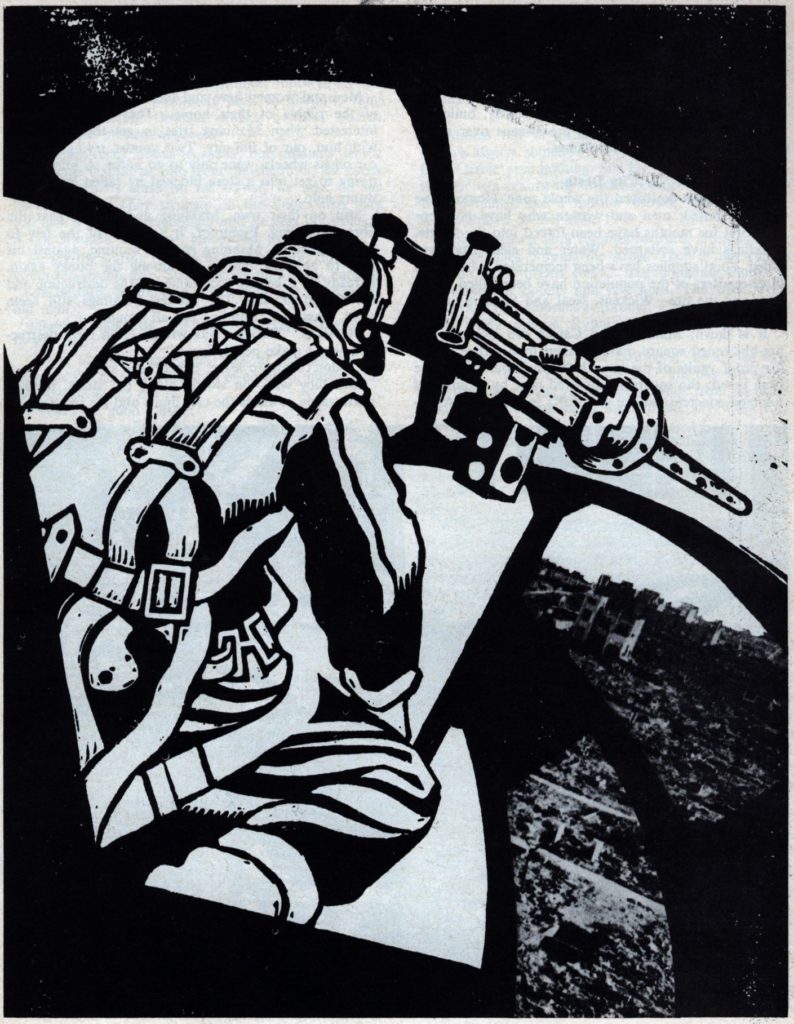 Yes: people are willing to go to war over Baked Beans!
Yes: people are willing to go to war over Baked Beans! A page showing some of Peake's imaginative artwork.
A page showing some of Peake's imaginative artwork. This illustration seems to sum up this odd story.
This illustration seems to sum up this odd story.